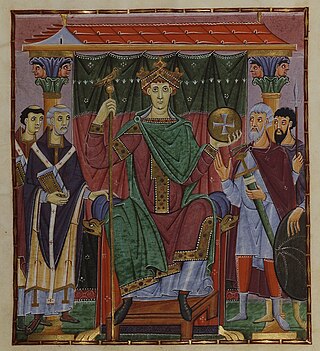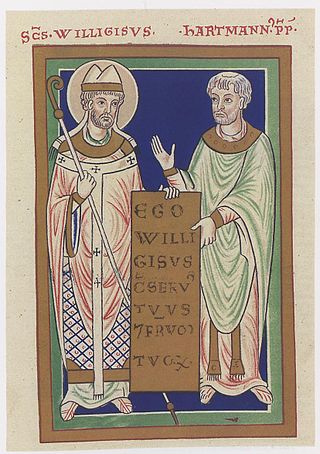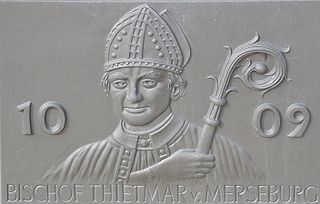This article has multiple issues. Please help improve it or discuss these issues on the talk page . (Learn how and when to remove these messages)
|
Thangmar (or Thankmar) (c.950- c.1003) was a German historian. [1]
This article has multiple issues. Please help improve it or discuss these issues on the talk page . (Learn how and when to remove these messages)
|
Thangmar (or Thankmar) (c.950- c.1003) was a German historian. [1]
His first appearance in history is as the head of the cathedral school at Hildesheim; at a later date he became dean of the Hildesheim Cathedral, and being at the same time notary and librarian his position was a very important one. [1] Thangmar was distinguished both as a scholar and a statesman; he taught several bishops including Bernward of Hildesheim, Meinwerk of Paderborn, and Benno of Meissen, as well as the Emperor Henry II. [1] He exercised great influence over Bernward of Hildesheim, and a large part of the affairs under episcopal control were directed by him.
In 1000 he accompanied Bernward to Rome, and was sent several times to the imperial court as the representative of the bishop to settle important matters, being highly esteemed by Emperor Otto III.
After the death of Bernward in 1022 he wrote an account of the active and varied life of the bishop, a biography for which he had already gathered the material and of which he had probably written the first ten chapters during the years 1008–13. He had been an eye-witness of many of the events he relates and had taken as active part in all important measures. As he says himself, Bernward trusted him as a child does its father. Consequently, his Vita Bernwardi is one of the finest biographical productions of the Middle Ages, and is also one of the most valuable authorities for an important period of German history.
He displays much affection for the dead bishop, and has written a plain and simple narrative, unrhetorical and truthful. It is only in the account of the dispute between the Archbishops of Hildesheim and Mainz as to the right of jurisdiction over Gandesheim that Thangmar appears at times to be a partisan of Bernward. Editions:
The life has been edited in German by Hüffer (Berlin, 1857), and by Wattenbach (Leipzig, 1892).

Otto III was the Holy Roman emperor from 996 until his death in 1002. A member of the Ottonian dynasty, Otto III was the only son of Emperor Otto II and his wife Theophanu.

Willigis was Archbishop of Mainz from 975 until his death as well as archchancellor of the Holy Roman Empire.

Gotthard, also known as Gothard or Godehard the Bishop, was a German bishop venerated as a saint.

Ottonian art is a style in pre-romanesque German art, covering also some works from the Low Countries, northern Italy and eastern France. It was named by the art historian Hubert Janitschek after the Ottonian dynasty which ruled Germany and Northern Italy between 919 and 1024 under the kings Henry I, Otto I, Otto II, Otto III and Henry II. With Ottonian architecture, it is a key component of the Ottonian Renaissance. However, the style neither began nor ended to neatly coincide with the rule of the dynasty. It emerged some decades into their rule and persisted past the Ottonian emperors into the reigns of the early Salian dynasty, which lacks an artistic "style label" of its own. In the traditional scheme of art history, Ottonian art follows Carolingian art and precedes Romanesque art, though the transitions at both ends of the period are gradual rather than sudden. Like the former and unlike the latter, it was very largely a style restricted to a few of the small cities of the period, and important monasteries, as well as the court circles of the emperor and his leading vassals.

The Church of St. Michael is an early-Romanesque church in Hildesheim, Germany. It has been on the UNESCO World Cultural Heritage list since 1985 because of its outstanding Romanesque architecture and art. It is now a shared church, the main church being Lutheran and the crypt being Roman Catholic.

Hildesheim Cathedral, officially the Cathedral of the Assumption of Mary or simply St. Mary's Cathedral, is a medieval Roman Catholic cathedral in the city centre of Hildesheim in Lower Saxony, Germany, that serves as the seat of the Diocese of Hildesheim. The cathedral has been on the UNESCO World Cultural Heritage list since 1985, together with the nearby St. Michael's Church because of its unique art and outstanding Romanesque architecture.

Thietmar, Prince-Bishop of Merseburg from 1009 until his death in 1018, was an important chronicler recording the reigns of German kings and Holy Roman Emperors of the Ottonian (Saxon) dynasty. Two of Thietmar's great-grandfathers, both referred to as Liuthar, were the Saxon nobles Lothar II, Count of Stade, and Lothar I, Count of Walbeck. They were both killed fighting the Slavs at the Battle of Lenzen.

Bernward was the thirteenth Bishop of Hildesheim from 993 until his death in 1022.

The Prince-Bishopric of Hildesheim was an ecclesiastical principality of the Holy Roman Empire from the Middle Ages until its dissolution in 1803. The Prince-Bishopric must not be confused with the Diocese of Hildesheim, which was larger and over which the prince-bishop exercised only the spiritual authority of an ordinary bishop.

Benno II was Bishop of Osnabrück from 1068 until his death. He served as a close advisor and architect of Emperor Henry IV. In 1080 he founded the Benedictine abbey of Iburg Castle.

Sophia I, a member of the royal Ottonian dynasty, was Abbess of Gandersheim from 1002, and from 1011 also Abbess of Essen. The daughter of Emperor Otto II and his consort Theophanu, she was an important kingmaker in medieval Germany.

The Hildesheim Reliquary of Mary is a historic and artistically unique reliquary in the Dommuseum in Hildesheim. It dates back to the early period of the diocese and is associated with the legend of the founding of the Cathedral.

The Hezilo chandelier is an 11th-century Romanesque wheel chandelier. It is part of the treasures of the Hildesheim Cathedral in Hildesheim, Germany, which has been a UNESCO World Cultural Heritage site since 1985. The chandelier was most likely commissioned by Bishop Hezilo of Hildesheim, who rebuilt the cathedral after a fire. He probably also influenced the program of imagery and inscriptions. It is the largest of four extant wheel chandeliers of the period; the others surviving examples are the Azelin chandelier, the Barbarossa chandelier in the Aachen Cathedral, and the Hartwig chandelier in the Abbey of Comburg.

The Bernward Doors are the two leaves of a pair of Ottonian or Romanesque bronze doors, made c. 1015 for Hildesheim Cathedral in Germany. They were commissioned by Bishop Bernward of Hildesheim (938–1022). The doors show relief images from the Bible, scenes from the Book of Genesis on the left door and from the life of Jesus on the right door. They are considered a masterpiece of Ottonian art, and feature the oldest known monumental image cycle in German sculpture, and also the oldest cycle of images cast in metal in Germany.

The Bernward Column also known as the Christ Column is a bronze column, made c. 1020 for St. Michael's Church in Hildesheim, Germany, and regarded as a masterpiece of Ottonian art. It was commissioned by Bernward, the thirteenth bishop of Hildesheim in 1020, and made at the same time. It depicts images from the life of Jesus, arranged in a helix similar to Trajan's Column: it was originally topped with a cross or crucifix. During the 19th century, it was moved to a courtyard and later to Hildesheim Cathedral. During the restoration of the cathedral from 2010 to 2014, it was moved back to its original location in St. Michael's, but was returned to the Cathedral in August 2014.

The Hildesheim Cathedral Museum is the treasury and diocesan museum of Hildesheim, which illustrates over a thousand years of art and church history in Lower Saxony. It is located in historic rooms off the southern transept of the Hildesheim Cathedral. During the cathedral renovations of 2010, the nearby church of St Antonius and part of the cathedral cloisters were converted into display rooms for the museum.

The Bernward Monument is a larger-than-life-sized bronze statue of Bishop Bernward of Hildesheim in the Domhof in Hildesheim. It was made by Ferdinand Hartzer in 1893 for the nine hundredth anniversary of St. Bernward's enthronement as Bishop of Hildesheim. On 7 September 2011, in the course of the renovations of Hildesheim Cathedral it was temporarily relocated to the garden of house 24, Domhof.
A royal election was held in the Kingdom of Germany after the death of childless Emperor Otto III. It was won by Duke Henry IV of Bavaria among accusations of uncustomary practices.

The Great Gandersheim Conflict was a conflict between the Archbishops of Mainz and the Bishops of Hildesheim concerning the jurisdiction over Gandersheim Abbey. It lasted from 987 to 1030, during the reign of the Ottonian emperors Otto III and Henry II as well as of their Salian successor Conrad II.

Hildesheim Charterhouse is a former Carthusian monastery or charterhouse in Hildesheim in Lower Saxony, Germany.
![]() This article incorporates text from a publication now in the public domain : Herbermann, Charles, ed. (1913). "Thangmar". Catholic Encyclopedia . New York: Robert Appleton Company.
This article incorporates text from a publication now in the public domain : Herbermann, Charles, ed. (1913). "Thangmar". Catholic Encyclopedia . New York: Robert Appleton Company.